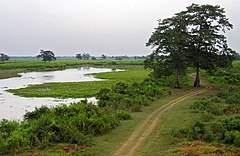Kaziranga National Park
| Kaziranga National Park | ||
|---|---|---|
| Kaziranga is the most important reserve of rhinoceros | ||
|
|
||
| Location: | Assam , India | |
| Next city: | Jorhat , Tezpur | |
| Surface: | 430 km² | |
| Founding: | 1905 | |
Kaziranga is an Indian national park in the state of Assam in the Karbi Anglong Hills landscape in northeastern India. The park area is bordered by the Brahmaputra in the north and by national road 37 in the south. The park has an area of 430 km² and consists of high grass corridors, forests and swamps. The national park is the most important protected area for the Indian rhinoceros and is home to over 70% of the world's total population. In addition, Kaziranga is one of the most important protected areas for wild water buffalo , Asian elephants , Bengal tigers and barasingha deer .
history
The establishment of the national park in 1905 goes back to the British statesman Lord Curzon , the then Viceroy of India . The national park administration is based in Bokahat ; four administrative stations are located in Agaratoli , Baguri , Burrhpahar and Kohora .
The core area of Kaziranga has been under protection since January 3, 1908 and has been repeatedly expanded by a few square kilometers. Since 1985, the Park is a World Heritage of UNESCO .
Climate and vegetation
The climate is characterized by the monsoons , hardly any precipitation falls between November and April, the rain in the other months is the mean of the annual precipitation about 1,830 mm. About two thirds of the park area is then flooded, also due to the Brahmaputra overflowing the banks , which deposits nutrient-rich mud. This natural fertilization creates high grass habitats and is a prerequisite for biodiversity in the national park. The average temperature in summer is 32 ° C and in winter 10 ° C.
Wildlife
Kaziranga is home to significant populations of rare large animal species. Around 2400 Indian rhinos (as of 2015), around 1250 Asian elephants (as of 2005) and over 1400 wild water buffalo (as of 2001) live in the park. The elephants sometimes form herds of up to 200 animals. The protected area is also home to around a hundred Bengal tigers (as of 2000) and around 470 specimens (as of 2000) of the rare Barasingha grouped deer, which is a special subspecies here. Sambar deer are represented with around 60 (as of 1999) and wild boars with around 430 animals (as of 1999). Other large herbivores are Indian muntjak deer , pig deer and gaure . In addition to tigers, large carnivores are Indian leopards , Asian wild dogs , collar bears and sloth bears . White-browed gibbon , cap langur , Assam macaque and rhesus monkey represent the primates of the reserve. Other notable species of mammals are fishing cat, jungle cat, Eurasian otter , small Indian civet , Indian civet , Indian gray mongoose , Small Indian mongoose , Bengal Fox , Golden Jackal , Chinese sunroof , hog badger , Orange-bellied Himalayan squirrel , Indian porcupine, Front Indian pangolin and South Asian river dolphin . Among the reptiles are Gavial , Bengal monitor , Asian Water Monitor , Kraits , king cobra , monocled cobra , Indian python and reticulated python to name.
Problems arise from the settlement around the national park. The region of the Karbi-Anglong Mountains, which covers approx. 10,500 km², is used for agriculture, around 800,000 people live here. Due to the extensive keeping of livestock, grazing cattle repeatedly invade the national park and bring in diseases (e.g. anthrax ) that are transmitted through direct contact with the wild animals or through excrement.
Conversely, during the rainy season from July / August to October, when the Brahmaputra floods large parts of the park , many wild animals move to higher areas, especially the Karbi Hills in the south, the Himalayan foothills in the north, and leave the protected area in the process. Indian rhinos and elephants are viewed by farmers as "agricultural pests" that trample the fields. The animals are therefore driven away or killed. Poachers also take advantage of the flood time and the lack of surveillance of the animals by gamekeepers to specifically capture the horn of the Indian rhinoceros.
literature
- KK Gurung & Raj Singh: Field Guide to the Mammals of the Indian Subcontinent , Academic Press, San Diego, ISBN 0-12-309350-3
Web links
- World Database on Protected Areas - Kaziranga National Park (English)
- Entry on the UNESCO World Heritage Center website ( English and French ).
Individual evidence
- ↑ UNESCO World Heritage Center: Kaziranga National Park. Retrieved August 25, 2017 .
- ↑ Bibhab Kumar Talukdar: Asian Rhino Specialist Group report. Pachyderm 56, 2015, pp. 40–43 ( [1] )
- ↑ Wildlife in Kaziranga National Park on kazirangatoursim.in accessed on July 23, 2011.











